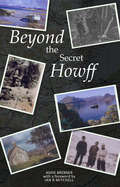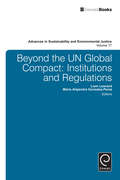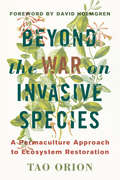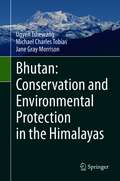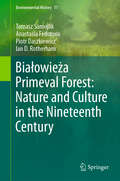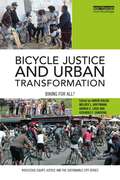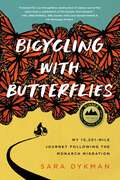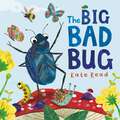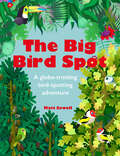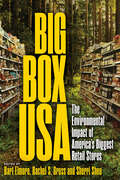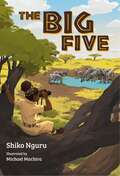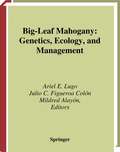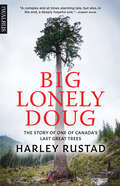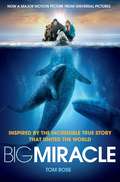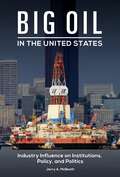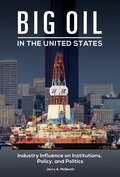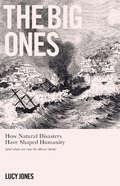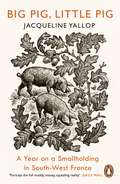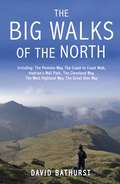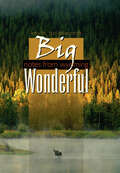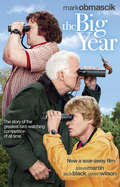- Table View
- List View
Beyond the Secret Howff
by Ashie BrebnerAs a young man with a compelling interest in the great outdoors and the natural world Allister (‘Ashie’) Brebner spent his precious weekends in the 1950s and early ’60s as a pioneer of the emerging Scottish bothying and mountaineering scene, and was one of the builders of the famed Secret Howff on Bheinn a’ Bhuird in the Cairngorms. At the start of the 1960s he threw in his steady, well-paid job as a factory worker and, with another companion who did the same, started as a pioneer of mountain and nature guiding in the Scottish Highlands. Here is the unique story of a working man whose odyssey took him from the tenements and factory work of Aberdeen to the mountains and islands of the Highlands, their people and their wildlife.
Beyond the UN Global Compact: Institutions and regulations (Advances in Sustainability and Environmental Justice #17)
by Liam Leonard Maria Alejandra Gonzalez-PerezThis book offers African, Asian, Latin American, European, and North American perspectives on institutions and regulations promoting sustainable economic growth in the post-2015 development agenda in areas such as environment, labour, risk management, corporate social responsibility, corporate governance, and innovation. The chapters address sustainability issues at the firm, national, regional and international levels from a multidisciplinary perspective. The chapters of this volume address the challenge of enhancing economic competitiveness of the supply side economies while pushing a sustainable development agenda. This work addresses the existing inequalities, environmental degradation, and economic/financial instability under current dynamics of international and domestic power relations in order to meet the set objectives for the post-2015 era. This volume advances the perspectives on the non-compulsory alternative to markets regulations, the United Nations Global Compact, explored in the previous volume 'The UN Global Compact: Fair Competition and Environmental and Labour Justice in International Markets' vol. 16.
Beyond the War on Invasive Species: A Permaculture Approach to Ecosystem Restoration
by Tao Orion David HolmgrenInvasive species are everywhere, from forests and prairies to mountaintops and river mouths. Their rampant nature and sheer numbers appear to overtake fragile native species and forever change the ecosystems that they depend on. Concerns that invasive species represent significant threats to global biodiversity and ecological integrity permeate conversations from schoolrooms to board rooms, and concerned citizens grapple with how to rapidly and efficiently manage their populations. These worries have culminated in an ongoing “war on invasive species,” where the arsenal is stocked with bulldozers, chainsaws, and herbicides put to the task of their immediate eradication. In Hawaii, mangrove trees (Avicennia spp.) are sprayed with glyphosate and left to decompose on the sandy shorelines where they grow, and in Washington, helicopters apply the herbicide Imazapyr to smooth cordgrass (Spartina alterniflora) growing in estuaries. The “war on invasive species” is in full swing, but given the scope of such potentially dangerous and ecologically degrading eradication practices, it is necessary to question the very nature of the battle. Beyond the War on Invasive Species offers a much-needed alternative perspective on invasive species and the best practices for their management based on a holistic, permaculture-inspired framework. Utilizing the latest research and thinking on the changing nature of ecological systems, Beyond the War on Invasive Species closely examines the factors that are largely missing from the common conceptions of invasive species, including how the colliding effects of climate change, habitat destruction, and changes in land use and management contribute to their proliferation. Beyond the War on Invasive Species demonstrates that there is more to the story of invasive species than is commonly conceived, and offers ways of understanding their presence and ecosystem effects in order to make more ecologically responsible choices in land restoration and biodiversity conservation that address the root of the invasion phenomenon. The choices we make on a daily basis—the ways we procure food, shelter, water, medicine, and transportation—are the major drivers of contemporary changes in ecosystem structure and function; therefore, deep and long-lasting ecological restoration outcomes will come not just from eliminating invasive species, but through conscientious redesign of these production systems.
Beyond Wild and Tame: Soiot Encounters in a Sentient Landscape (Interspecies Encounters #2)
by Alex C. OehlerResponding to recent scholarship, this book examines animal domestication and offers a Soiot approach to animals and landscapes, which transcends the wild-tame dichotomy. Following herder-hunters of the Eastern Saian Mountains in southern Siberia, the author examines how Soiot and Tofa households embrace unpredictability, recognize sentience, and encourage autonomy in all their relations with animals, spirits, and land features. It is an ethnography intended to help us reinvent our relations with the earth in unpredictable times.
Bhutan: Conservation and Environmental Protection in the Himalayas
by Ugyen Tshewang Michael Charles Tobias Jane Gray MorrisonLocated in the heart of the Eastern Himalayas, Bhutan practices the philosophy of Gross National Happiness (“GNH”) that embraces environmental conservation as one of the main building blocks for its sustainable development goals. Bhutan’s conservation strategies and success are largely driven by the strong political will and visionary leadership of His Majesty the King of Bhutan The nation’s Buddhist perspectives regarding a deep and abiding respect for nature; and the strategic enforcement of a wide-ranging stringent set of internal regulations and controls have helped ensure ecological gold standards in Bhutan. Moreover, the country is an active member of the international conservation community by fulfilling its implementation of various Multilateral Environment Agreements. While it emerged into the 21st century as one of the 36 global terrestrial “hotspots” in biological diversity conservation ranks, Bhutan’s sheer commitment with more than 51% of its territory being managed under the explicit status of a protected area network, and more than 70% of the land under forest cover, represents Bhutan’s exemplary dedication to protect the planet despite its smallness in size and economy, and the biological fragility exemplified by its hotspot situation. In the face of imminent severe threats of global warming, Bhutan nonetheless exemplifies the truth that “a small country with a big conservation commitment” can make an enormous contribution to the global community.At the regional level, Bhutan is intent upon protecting the Water Towers of Asia (that glacial expanse of the Himalayas) which is a critical resource bulwark for about one-fifth of the global population downstream in South Asia. Such protections invariably help mitigate climate change by acting as a nation-wide carbon sink through its carbon neutral policies. In short, Bhutan has long represented one of the world’s foremost national guardians of biodiversity conservation, ecological good governance, and societal sustainability at a period when the world has entered the Anthropocene – an epoch of mass extinctions.We envision this publication to be ecologically and ethically provocative and revealing for the concerned scientific communities, and governments. Through an extensive review of the scientific and anthropological literature, as well as the research team's own data, the Author's have set forth timely recommendations for conservation policies, strategies and actions. This book provides technical and deeply considered assessments of the state of Bhutan’s environment, its multiple, human-induced stressors and pressures; as well as extremely sound, practical techniques that would address conservation strategies in the Himalayas and, by implication, worldwide.
Białowieża Primeval Forest: Nature and Culture in the Nineteenth Century (Environmental History #11)
by Tomasz Samojlik Ian D. Rotherham Anastasia Fedotova Piotr DaszkiewiczUnderstanding the current state and dynamics of any forest is extremely difficult - if not impossible - without recognizing its history. Białowieża Primeval Forest (BPF), located on the border between Poland and Belarus, is one of the best preserved European lowland forests and a subject of myriads of works focusing on countless aspects of its biology, ecology, management. BPF was protected for centuries (15th-18th century) as a game reserve of Polish kings and Lithuanian grand dukes. Being, at that time, a part of the Grand Duchy of Lithuania, BPF was subject to long-lasting traditional, multi-functional utilisation characteristic for this part of Europe, including haymaking on forest meadows, traditional bee-keeping and fishing in rivers flowing through forest. This traditional model of management came to an abrupt end due to political change in 1795, when Poland and Grand Duchy of Lithuania ceased to exist in effect of partitioning by neighbouring countries, and the territory of BPF was taken over by the Russian Empire. The new Russian administration, influenced by the German trends in forestry, attempted at introducing the new, science-based forestry model in the BPF throughout the 19th century. The entire 19th century in the history of BPF is a story of struggle between new trends and concepts brought and implemented by new rulers of the land, and the traditional perception of the forest and forest uses, culturally rooted in this area and originating from mediaeval (or older) practices.The book will show the historical background and the outcome of this struggle: the forest’s history in the long 19th century focusing on tracking all cultural imprints, both material (artificial landscapes, introduced alien species, human-induced processes) and immaterial (traditional knowledge of forest and use of forest resources, the political and cultural significance of the forest) that shaped the forest’s current state and picture. Our book will deliver a picture of a crucial moment in forest history, relevant not only to the Central Europe, but to the continent in general. Moment of transition between a royal hunting ground, traditional type of use widespread throughout Europe, to a modern, managed forest. Looking at main obstacles in the management shift, the essential difference in perceptions of the forest and goods it provides in both modes of management, and the implications of the management change for the state of BPF in the long 19th century could help in better understanding the changes that European forests underwent in general.
Bicycle Justice and Urban Transformation: Biking for all? (Routledge Equity, Justice and the Sustainable City series)
by Aaron Golub Melody L. Hoffmann Adonia E. Lugo Gerardo F. SandovalAs bicycle commuting grows in the United States, the profile of the white, middle-class cyclist has emerged. This stereotype evolves just as investments in cycling play an increasingly important role in neighborhood transformations. However, despite stereotypes, the cycling public is actually quite diverse, with the greatest share falling into the lowest income categories. Bicycle Justice and Urban Transformation demonstrates that for those with privilege, bicycling can be liberatory, a lifestyle choice, whereas for those surviving at the margins, cycling is not a choice, but an often oppressive necessity. Ignoring these "invisible" cyclists skews bicycle improvements towards those with choices. This book argues that it is vital to contextualize bicycling within a broader social justice framework if investments are to serve all street users equitably. "Bicycle justice" is an inclusionary social movement based on furthering material equity and the recognition that qualitative differences matter. This book illustrates equitable bicycle advocacy, policy and planning. In synthesizing the projects of critical cultural studies, transportation justice and planning, the book reveals the relevance of social justice to public and community-driven investments in cycling. This book will interest professionals, advocates, academics and students in the fields of transportation planning, urban planning, community development, urban geography, sociology and policy.
Bicycle Justice and Urban Transformation: Biking for all? (Routledge Equity, Justice and the Sustainable City series)
by Aaron Golub Melody L. Hoffmann Adonia E. Lugo Gerardo F. SandovalAs bicycle commuting grows in the United States, the profile of the white, middle-class cyclist has emerged. This stereotype evolves just as investments in cycling play an increasingly important role in neighborhood transformations. However, despite stereotypes, the cycling public is actually quite diverse, with the greatest share falling into the lowest income categories. Bicycle Justice and Urban Transformation demonstrates that for those with privilege, bicycling can be liberatory, a lifestyle choice, whereas for those surviving at the margins, cycling is not a choice, but an often oppressive necessity. Ignoring these "invisible" cyclists skews bicycle improvements towards those with choices. This book argues that it is vital to contextualize bicycling within a broader social justice framework if investments are to serve all street users equitably. "Bicycle justice" is an inclusionary social movement based on furthering material equity and the recognition that qualitative differences matter. This book illustrates equitable bicycle advocacy, policy and planning. In synthesizing the projects of critical cultural studies, transportation justice and planning, the book reveals the relevance of social justice to public and community-driven investments in cycling. This book will interest professionals, advocates, academics and students in the fields of transportation planning, urban planning, community development, urban geography, sociology and policy.
Bicycling with Butterflies: My 10,201-Mile Journey Following the Monarch Migration
by Sara DykmanScience, nature, and adventure come together in Sara Dykman's riveting account of her solo bike trip along the 10,201 mile-long migratory path of the monarch butterfly.
The Big Bad Bug: A Minibeast Mini Drama
by Kate ReadA richly colourful minibeast adventure from Kate Read, multi-award-winning creator of One Fox: A Counting Book Thriller.The Big Bad Bug, a self-proclaimed 'very rare species' is used to getting his own way, but claiming a giant berry all for himself is a step too far . . . Will he ever learn to share, and mend his bullying ways?This bug's eye view from the bottom of the garden will entrance any young child and show them the value of kindness and community. The Big Bad Bug is the perfect picture book for minibeast fans.
The Big Bird Spot
by Matt SewellTravel the world to a variety of amazing locations – from jungle to desert to woodland to ocean and see if you can spot the birds that are hiding there. It's harder than you think!
Big Box USA: The Environmental Impact of America’s Biggest Retail Stores (Path to Open)
by Bart Elmore Rachel S. Gross Sherri SheuBig Box USA presents a new look at how the big box retail store has dramatically reshaped the US economy and its ecosystems in the last half century. From the rural South to the frigid North, from inside stores to ecologies far beyond, this book examines the relationships that make up one of the most visible features of late twentieth-century and early twenty-first-century American life. The rise of big box retail since the 1960s has transformed environments on both local and global scales. Almost everyone has explored the aisles of big box stores. The allure of “everyday low prices” and brightly colored products of every kind connect shoppers with a global marketplace. Contributors join a growing conversation between business and environmental history, addressing the ways American retail institutions have affected physical and cultural ecologies around the world. Essays on Walmart, Target, Cabela’s, REI, and Bass Pro Shops assess the “bigness” of these superstores from “smokestacks to coat racks” and contend that their ecological impacts are not limited to the footprints of parking lots and manufacturing but also play a didactic role in educating consumers about their relationships with the environment. A model for historians seeking to bring business and environmental histories together in their analyses of merchant capital’s role in the landscapes of everyday life and how it has remade human relationships with nature, Big Box USA is a must-read for students and scholars of the environment, business, sustainability, retail professionals, and a general audience.
Big-Leaf Mahogany: Genetics, Ecology, and Management (Ecological Studies #159)
by Ariel E. Lugo Julio C. Figueroa Ón Mildred AlayónBig-Leaf Mahogany is the most important commercial timber species of the tropics. Current debate concerning whether to protect it as an endangered species has been hampered by the lack of complete, definitive scientific documentation. This book reports on vital research on the ecology of big-leaf mahogany, including genetic variations, regeneration, natural distribution patterns and the silvicutural and trade implications for the tree.
Big Lonely Doug: The Story of One of Canada’s Last Great Trees
by Harley RustadIn the tradition of John Vaillant’s modern classic The Golden Spruce comes a story of the unlikely survival of one of the largest and oldest trees in Canada.On a cool morning in the winter of 2011, a logger named Dennis Cronin was walking through a stand of old-growth forest near Port Renfrew on Vancouver Island. He came across a massive Douglas fir the height of a twenty-storey building. Instead of allowing the tree to be felled, he tied a ribbon around the trunk, bearing the words “Leave Tree.” The forest was cut but the tree was saved. The solitary Douglas fir, soon known as Big Lonely Doug, controversially became the symbol of environmental activists and their fight to protect the region’s dwindling old-growth forests.Originally featured as a long-form article in The Walrus that garnered a National Magazine Award (Silver), Big Lonely Doug weaves the ecology of old-growth forests, the legend of the West Coast’s big trees, the turbulence of the logging industry, the fight for preservation, the contention surrounding ecotourism, First Nations land and resource rights, and the fraught future of these ancient forests around the story of a logger who saved one of Canada's last great trees.
Big Miracle: Three Trapped Whales, One Small Town, A Big-Hearted Story of Hope
by Tom RoseIn October 1988 an Inuit hunter saw three grey whales trapped in the frozen Arctic ocean near Barrow, an isolated Alaskan outpost. They were working together to keep their blow hole open, the two adolescents caring for the weaker baby. It was a poignant sight. Filmed by a local television reporter, this tiny regional news story snowballed into a global media frenzy. In this gripping, insightful book Tom Rose describes how journalists poured into Barrow, all woefully ill equipped for the sub-zero temperatures, warming up on bootleg alcohol. As the locals cheerfully found ways to profit from the visitors, Greenpeace activist Cindy Lowry battled to mount an extraordinary rescue operation that would unite conservationists and oil companies, the Inuit and the military, President Reagan and the Kremlin. 'At times a marvellously funny story . . . Beneath the heartwarming aspect of the rescue are darker tales of human greed, and about the power television has acquired to set the agenda of the news' Washington Post 'Few novels could match the characters, plot and dramatic tension' Chicago Tribune
Big Oil in the United States: Industry Influence on Institutions, Policy, and Politics
by Jerry A. McBeathThis book explains how and why large oil-producing corporations have affected government institutions, energy policy, and politics in the United States—and suggests how their influence can be reduced.Big oil is the leading factor in U.S. energy politics today; the largest oil-producing companies also constitute a formidable force and interest group in American politics. This book examines why oil is so important and how the prominence of huge corporations—often working in the absence of countervailing forces—has affected government institutions, policy (with a focus on energy policy), and politics in the United States.Analyzing big oil's influence on political outcomes, particularly through campaign contributions and lobbying, this book shows how strong corporate power affects political participation. The book documents how the influence of big oil flows in all directions, intricately connecting U.S. policies at all levels—foreign policy, federal, state, and even local—regarding oil exploration, development, production, and transportation. Readers will come away with a clear understanding of how these multi-tiered relationships between oil corporations and governments work to the advantage of corporations—and to the disadvantage of states and the citizens they represent.
Big Oil in the United States: Industry Influence on Institutions, Policy, and Politics
by Jerry A. McBeathThis book explains how and why large oil-producing corporations have affected government institutions, energy policy, and politics in the United States—and suggests how their influence can be reduced.Big oil is the leading factor in U.S. energy politics today; the largest oil-producing companies also constitute a formidable force and interest group in American politics. This book examines why oil is so important and how the prominence of huge corporations—often working in the absence of countervailing forces—has affected government institutions, policy (with a focus on energy policy), and politics in the United States.Analyzing big oil's influence on political outcomes, particularly through campaign contributions and lobbying, this book shows how strong corporate power affects political participation. The book documents how the influence of big oil flows in all directions, intricately connecting U.S. policies at all levels—foreign policy, federal, state, and even local—regarding oil exploration, development, production, and transportation. Readers will come away with a clear understanding of how these multi-tiered relationships between oil corporations and governments work to the advantage of corporations—and to the disadvantage of states and the citizens they represent.
The Big Ones: How Natural Disasters Have Shaped Us (And What We Can Do About Them)
by Dr Lucy JonesWhen the forces that give our planet life exceed our ability to withstand them, they become disasters. Together they have shaped our cities and architecture, elevated leaders and toppled governments, influenced the way we think, feel, fight, unite and pray. The history of natural disasters is a history of ourselves. The Big Ones investigates some of the most impactful natural disasters, and how their reverberations are still felt today. From a volcanic eruption in Pompeii challenging and reinforcing prevailing views of religion, through the California floods of 1862 and the limitations of memory, to what Hurricane Katrina and the 2004 tsunami can tell us about governance and globalisation. With temperatures rising around the world, natural disasters are striking with ever greater frequency. More than just history or science, The Big Ones is a call to action. Natural hazards are inevitable; human catastrophes are not. With this energising and richly-researched book, Jones offers a look at our past, readying us to face down the Big Ones in our future.
Big Pacific: Passionate, Voracious, Mysterious, Violent
by Rebecca TansleyThe Pacific Ocean covers one-third of Earth’s surface—more than all of the planet’s landmasses combined. It contains half of the world’s water, hides its deepest places, and is home to some of the most dazzling creatures known to science. The companion book to the spectacular five-part series on PBS produced by Natural History New Zealand, Big Pacific breaks the boundaries between land and sea to present the Pacific Ocean and its inhabitants as you have never seen them before.Illustrated in full color throughout, Big Pacific blends a wealth of stunning Ultra HD images with spellbinding storytelling to take you into a realm teeming with exotic life rarely witnessed up close—until now. The book is divided into four sections, each one focusing on an aspect of the Pacific. "Passionate Pacific" looks at the private lives of sea creatures, with topics ranging from the mating behaviors of great white sharks to the monogamy of wolf eels, while "Voracious Pacific" covers hunting and feeding. In "Mysterious Pacific," you will be introduced to the Pacific’s more extraordinary creatures, like the pufferfish and firefly squid, and explore some of the region’s eerier locales, like the turtle tombs of Borneo and the skull caves of Papua New Guinea. "Violent Pacific" examines the effects of events like natural disasters on the development of the Pacific Ocean’s geography and the evolution of its marine life.Providing an unparalleled look at a diverse range of species, locations, and natural phenomena, Big Pacific is truly an epic excursion to one of the world’s last great frontiers.Five-part series on PBS:Big Pacific will air Wednesdays on PBS, June 21-July 19, 2017
Big Pig, Little Pig: A Year on a Smallholding in South-West France
by Jacqueline YallopAs heard on BBC Radio 4's Book of the Week'A delightful and entertaining memoir' Woman and HomeWhen Jacqueline moves to south-west France with her husband, she embraces rural village life and buys two pigs to rear for slaughter. But as she gets to know the animals better, her English sentimentality threatens to get in the way and she begins to wonder if she can actually bring herself to kill them. This is a memoir about that fateful decision, but it's also about the ethics of meat eating in the modern age, and whether we should know, respect and even love the animals we eat. At its heart, this book is a love story, exploring the increasing attachment of the author for her particular pigs, and celebrating the enduring closeness of humans and pigs over the centuries.
The Big Walks of the North
by David BathurstDavid Bathurst has unlaced his boots to produce this definitive companion to the ten best-loved long-distance footpaths in the north of Britain, with each split into manageable sections. Combining detailed descriptions with an appreciation of the beauty and history of the British countryside, this in an indispensable guide for all walkers.
Big Wonderful: Notes from Wyoming
by Kevin HoldsworthIn this unconventional memoir, Kevin Holdsworth vividly portrays life in remote, unpredictable country and ruminates on the guts - or foolishness - it takes to put down roots and raise a family in a merciless environment. Growing up in Utah, Holdsworth couldn't wait to move away. Once ensconced on the East Coast, however, he found himself writing westerns and dreaming of the mountains he'd skied and climbed. Fed up with city life, he moved to a small Wyoming town. In Big Wonderful, he writes of a mountaineering companion's death, the difficult birth of his son, and his father's terminal illness - encounters with mortality that sharpened his ideas about risk, care, and commitment. He puts a new spin on mountaineering literature, telling wild tales from his reunion with the mountains but also relating the surprising willpower it took to turn back from risks he would have taken before he became a father. He found he needed courage to protect and engage deeply with his family, his community, and the wild places he loves. Holdsworth's essays and poems are rich with anecdotes, characters, and vivid images. Readers will feel as if they themselves watched a bear destroy an entire expedition's food, walked with his great-great-grandmother along the icy Mormon Trail, and tried to plant a garden in Wyoming's infamous wind. Readers who love the outdoors will enjoy this funny and touching take on settling down and adventuring in the West's most isolated country.
The Big Year: A Tale Of Man, Nature, And Fowl Obsession
by Mark ObmascikEach year, hundreds of people set out across North America determined to set a new record in a spectacularly competitive event. Is it tennis? Golf? Racing? Poker perhaps? No, it's bird-watching, and a contest known as the Big Year - a grand, gruelling, expensive (and occasionally vicious) 365-day marathon to identify the most species.THE BIG YEAR is the rollicking chronicle of the 275,000-mile odyssey of three unlikely adventurers who take their bird-watching so seriously it nearly kills them. From Texas in pursuit of the Rufus-capped Warbler to British Columbia in search of Xantus' Hummingbird, these obsessive enthusiasts brave roasting deserts, storm-tossed oceans, infested swamps and disgruntled lions (not to mention some of the lumpiest hotel mattresses known to man) as they vie to become North America's number one bird-watcher in what would prove to be the biggest Big Year of them all...This captivating tour of human and avian nature, of courage and deceit, of passion and paranoia reveals the extremes to which Man will go to pursue his dreams, to conquer and to categorize...
Bigfoot Mountain
by Rod O'GradyMinnie and her stepfather, Dan, are stuck in their small cabin at the foot of the mountain struggling to come to terms with the death of her mother – and each other. But when Minnie and her friend Billy discover four giant footprints on a mountain trail, everything changes.Kaayii and his clan have to move across the mountain to escape huge forest fires, but find their ancient paths blocked by new holiday cabins… As Minnie and Kaayii’s paths unexpectedly entwine, can they help each other, and heal their families?
